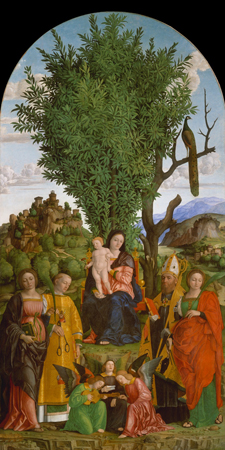Green Victory
The evergreen bay laurel (Laurus nobilis), a symbol of victory and eternal life, is not as tender as some other Mediterranean species, but it must be grown in pots and wintered over indoors at The Cloisters. Above, left: Bay laurel topiaries like this one spend the winter in the glassed-in arcades of Cuxa cloister and return to Bonnefont herb garden in May. Right: The magnificent bay tree that flourishes at the center of Girolamo dai Libri’s Madonna and Child with Saints represents Resurrection, and is juxtaposed with the naked limbs of a dead tree.
The laurel itself is a bringer of peace, inasmuch as to hold a branch of it out even between enemy armies is a token of cessation of hostilities. With the Romans especially it is used as a harbinger of rejoicing and of victory, accompanying despatches and decorating the spears and javelins of the soldiery and adorning the generals??? rods of office. From this tree a branch is deposited in the lap of Jupiter the All-good and All-great whenever a fresh victory has brought rejoicing, and this is not because the laurel is continually green, nor yet because it is an emblem of peace, as the olive is to be preferred in both respects, but because it flourishes in the greatest beauty on Mount Parnassus, and consequently is thought to be also dear to Apollo, to whose shrine even the kings of Rome at that early date were in the custom of sending gifts and asking for oracles in return.
???Pliny, Historia Naturalis, Book XV, 133



